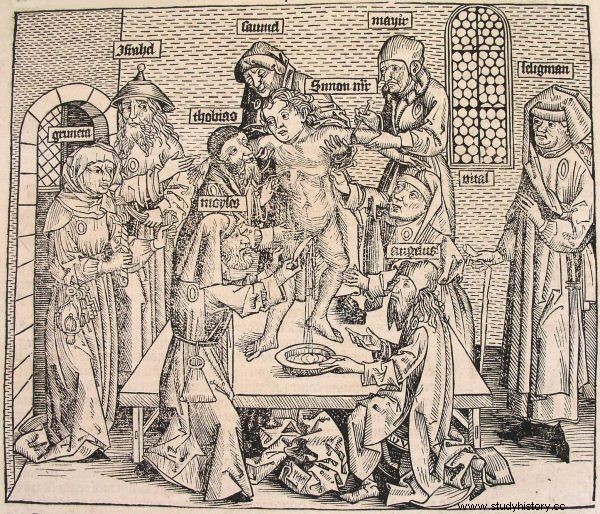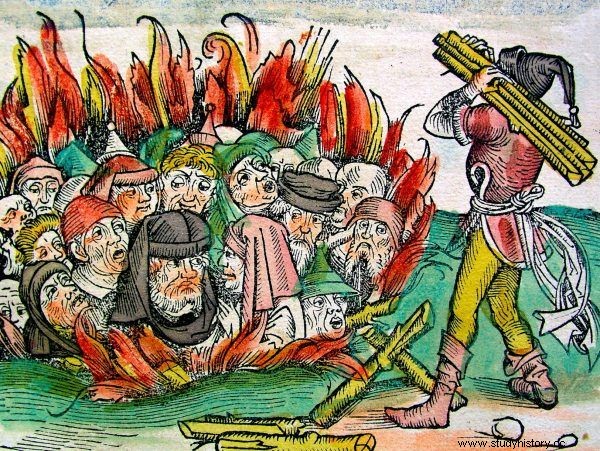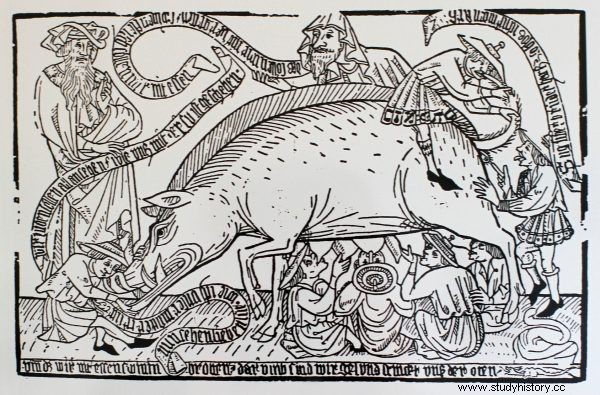They were to be enemies of Christ and all mankind. Crafty, greedy, smelly and hungry for Christian blood. Kidnapping and murdering innocent children was not the worst crime they were accused of.
1144, England. Just before Easter, the son of a wealthy peasant, William, disappears in Norwich. Two days later, his mutilated body is found in a forest near the city. The family makes an accusation against the Jews:they were supposed to murder the young man in order to repeat the passion of Christ. The accused are rescued by the local sheriff as the king's subjects.
Soon miracles begin to happen around the tomb of the deceased, and in 1150 the first life of St. William the Martyr. Pilgrims begin to arrive in Norwich, and news of the alleged Jewish conspiracy spreads throughout Europe. First, in England, then in France, Germany, Spain, Switzerland and Italy, there are further accusations of ritual murder.
Other accused pleaded guilty to torture. Whenever a Christian boy disappears, suspicion can always fall on the Jews. There are even blackmailers who make accusations and withdraw them in exchange for money. There are other accusations of ritual murders:profaning the host. Papal bulls explaining to the faithful that religion forbids the followers of Moses from making human sacrifices and eating blood do not help.
The Jews were believed to know the truth about the Savior and the transformation of bread and wine into his flesh and blood. The refusal to convert was to result from inborn wickedness and stubbornness, and the purpose of the murders and profanation of the sacrament was to insult Christianity. Blood was also to be needed by the Jews to make matzo or as a medicine, as well as an ingredient used in various types of magical practices.

Christian child disappeared? This is definitely the work of the local Jews! The figure shows how the ritual of consecrating a child by the Old Believers looked like according to Hartmann Schedel (The Nuremberg Chronicle of 1493, source:public domain).
Historians have counted 80 to 150 allegations of ritual murder in medieval Western Europe. Some of the accused avoided punishment, but there were also mass pogroms caused by slander. From the sixteenth century on, the number of such cases decreased in the West of the continent, but increased in the East. In the modern era, at least 100 trials for ritual murder took place in the Polish-Lithuanian Commonwealth.
This myth turned out to be extremely lively. In 1946, a rumor that a boy had been kidnapped by Jews led to a pogrom in Kielce. The ritual murders, however, were not the only accusations made against the followers of Moses. According to popular beliefs, the Orthodox Jews:
1. They pissed on the meat and poisoned the wells
The stereotype that was widespread in Western Europe about Jews was that they were often poisoned. This was especially true of Mosaic doctors, whose patients happened to die. One of the first to be accused in a similar case was a scientist who looked after the health of the ruler of the Franks, Karol the Bald. An innocent man was probably accused in 877 of the premature expedition of the emperor to the other world.
In 1161, an alleged conspiracy of Jewish medics was discovered in Bohemia. As many as 86 people were burned after the investigation , guilty of poisoning the population. In 1267, the councils in Vienna and Wrocław ruled that food should not be bought from the Orthodox Jews, as it may be seasoned with something deadly. One of the superstitions also said that Jewish children pee on meat sold to Christians ...
In the 14th century, accusations of poisoning wells began to appear in the Reich, Switzerland and France. In 1320 in Aquitaine, the revolted peasantry carried out mass pogroms during the so-called second shepherds crusade. Only a year later, news of a monstrous plot spread around the area.
Here the Jews were to persuade lepers to throw pouches with a deadly mixture into wells throughout the country. According to one version, it was to consist of human blood, urine, three unknown herbs and powdered host. Others believed that toad paws, a snake's head and woman's hair were used, along with some foul-smelling liquid. As if that were not enough, ties of the conspirators with the Muslim rulers of Granada and Tunis were discovered, and some said that the devil was behind everything ...

Ordinary water, or maybe poisoned by the Orthodox Jews? Who knows, maybe such thoughts were circulating in the head of this lady ... Picture from the 14th-century textbook of healthy life "Tacuinum Sanitatis" (source:public domain).
2. They caused the Black Death
But the worst was yet to come. In 1347, the Black Death appeared in Europe. The terrible plague claimed thousands of lives, and the living began to search for its causes. The culprits were quickly found.
Already in May 1348, in one of the Provencal towns, local Jews were burnt for allegedly poisoning a well. From there, rumors of such a lineage of the Black Death made their way to Savoy and Switzerland. In Chillon on Lake Geneva, the Orthodox Jews who were taken to torture pleaded guilty. One of them testified that he carried out his criminal activities in the area from southern Italy to Venice and Toulouse.
In Chambéry, Savoie, a Jew from Toledo allegedly distributed poison pouches among his fellow believers. It was made of the hearts of Christians, spiders, frogs, lizards, human flesh and hosts. All this, after mixing, was to end up in rivers and wells.

The belief that it was the Jews who brought the Black Death to Europe led to a wave of pogroms. This miniature shows the burning of Jews, accused of spreading the plague (Michel Wolgemut, Wilhelm Pleydenwurff, "Die Schedelsche Weltchronik", source:public domain).
Rumors and information about the conspiracy spread rapidly, the testimonies forced by the executioners were poured out. The bull of Pope Clement VI, who in September 1348 cleared the unjustly accused of charges, was of no avail. The Holy Father argued in vain that the Jews were dying too, and that the plague also appeared where none of them lived.
At about the same time, the Bern authorities not only executed local Orthodox Jews, but also notified Basel, Strasbourg and Cologne of the alleged danger. In the last two cities, local Jews were burned down even before the Black Death reached there. In Stuttgart, a fire consumed the followers of Moses two years before the plague.
The myth of disease spreading remained alive in the following centuries, at least until the 17th century. In 1580, in Provence, the Jews were to cause an epidemic with poison obtained in a very peculiar way. They allegedly prepared a lethal ointment from the saliva of a red-haired man who was tied to a cross on a hot day, whose back was bitten by vipers. In another variant, these snakes gnawed at the breasts of a red-haired woman buried in the ground so that only a part of her body protrudes from the bust upwards.
3. They had intercourse with pigs
In the 13th century, the image of judensau was born in areas associated with German culture , that is, the Jewish pig. They were obscene representations of Orthodox Jews sucking on a sow's nipples, copulating with her, hugging and licking her rump, eating her droppings and riding her, face to tail, of course. There were also stories about Jewish women giving birth to piglets or pigs giving birth to Jewish children.

Almost everything a Jew - in the mind of the former Germans - can do with a pig, in one figure. Anti-Semitic illustration from the 15th century, part of the permanent exhibition at Kulturhaus Wittlich in the Rhineland (source:public domain).
This theme made a huge career. It was reproduced in drawings, print, sculpture, in the form of mascarons in churches, on canvas, porcelain, heads of walking sticks ... to Polish folklore, in which the pig was called "Jewish aunt" and was later used in Nazi propaganda.
4. They stank by God's will
However, these absurd ideas about the Orthodox Jews did not end there. Medieval origins were also believed by the beliefs, alive at least until the 17th century, about various ailments that were to plague the representatives of the chosen people.
The punishment for the martyrdom of Christ was supposed to be:purulent ulcers on the skin, menstruation of men, susceptibility to hemorrhoids and scrofulosis (tuberculosis of the lymph nodes), corpse pallor ... These ailments were, of course, to be hidden or treated with magic and - how else - with the blood of Christians.
In 1602, a baptized Jew from Piacenza published a work which included a catalog of such ailments, different for each tribe of Israel. Some were to suffer from open wounds appearing on their bodies, others were characterized by pig ears, teeth and smell. The descendants of Benjamin spit worms as they spoke, the sons of Levi could not get rid of phlegm, etc. etc.
Finally, it was a common belief in Europe that the followers of Moses had a terrible stench because they exudate the so-called foetor judaicus , removed only by baptism (though not necessarily). And this myth turned out to be so persistent that even the Nazis proved that Jews spread a smell specific to their race.
5. They were devils
Myths about a close relationship with pigs or an unbearable stench are signs of a more general phenomenon:dehumanization of the Orthodox Jews. Especially in folk culture, they were seen more as incarnations of the devil himself than members of the human race.

Even if the Jews were not portrayed as devils, they were undoubtedly damned. Detail from the 12th-century "Garden of Pleasure" (source:public domain).
Peter the Venerable, abbot of the famous monastery in Cluny, wrote in the 12th century:
I really doubt a Jew can be a human , since he does not submit to human reasoning and does not settle for authoritative statements, both divine and Jewish .
It was, of course, a "stubborn" rejection of the truth about Christ as the messiah.
Legends popular in medieval Europe showed the Jew, if not as Satan in himself, then as his servant, associate, and even commander. In iconography, devils had "Semitic" features emphasized, often wore the same markings (e.g. pointed hats) that were ordered by the followers of Moses, and accompanied the images of judensau .
The Jews, on the other hand, were depicted with goat horns or a goatee and a tail. Jews were also to ride trestles - just like pigs - face back. The late medieval nursery rhyme read:
When Icyk arrived
On the bearded goat,
the Jews took for God
What he was walking on.

That big, folded kichol ... it must be devil's seed! On the left, an English caricature from 1277, signed "Aaron, the son of the Devil", on the right, a detail from the Bamberg "Gründungslegende", created in the 17th century, but telling about the 14th century Simon theft (source:public domain).
The Messiah, who was expected by the followers of Moses, was identified with the Antichrist, and the "synagogue of Satan" was to be the opposite of the Church. Prominent noses, an integral part of 19th and 20th century caricatures of Jews, also come from medieval and modern depictions. A huge, curved nose was then associated with licentiousness, deviation and devilishness.
***
Pierre de Lancre, the French witch hunter, wrote in the early 17th century:
Jews can only be disgusted with, and since they are true criminals against God and against people, they deserve punishment and the worst suffering:heat, molten lead, boiling oil, tar, wax and sulfur are all taken together and so is not enough to punish them properly for the cruel crimes they usually commit.
The author was a specialist in this type of issues. He had around 70 people burned at the stake for indulging in black magic and was the author of three books on witchcraft. In his opinion, the Jews were worse than the demons and practiced identical to those practiced by all kinds of witches. For centuries, such views were commonplace.
Inspiration:
The publication of this article was inspired by Marek Toman's novel Scary News about the cruel murder of Szymon Abeles .
Bibliography:
- Peter Burke, Folk Culture in Early Modern Europe , Publishing House of the University of Warsaw, Warsaw 2009.
- Alina Cała, The image of a Jew in Polish folk culture , Oficyna Naukowa, Warsaw 2005.
- Taż, Jew - the eternal enemy? Antisemitism in Poland and its sources , Jewish Historical Institute, Warsaw 2012.
- Jean Delumeau, Fear in Western culture 14th – 18th centuries. A besieged city , Volumen, Warsaw 2011.
- Gershon David Hundert, Jews in the Polish-Lithuanian Commonwealth in the 18th century. Genealogy of modernity , Cyclades, Warsaw 2007.
- Paul Johnson, History of the Jews , Platan, Krakow 1993.
- Ritual murder. A legend in European history , ed. Susanna Buttaroni, Stanisław Musiał SJ, Association for Cultural Initiatives, Kraków 2003.
- Léon Poliakov, A History of Anti-Semitism , vol. 1, The Age of Faith , Universitas, Kraków 2008.
- Joanna Tokarska-Bakir, Ganz Andere? A Jew as a Witch and a Witch as a Jew in Polish and foreign ethnographic sources, or how to read interrogation reports , "Res Publica Nowa", 2001, No. 8, pp. 3–31.
- Joshua Trachtenberg, The Devil and the Jews. The Medieval Concept of the Jew and Contemporary Anti-Semitism , Uraeus, Gdynia 1997.
- Jolanta Żyndul, A lie of blood. The legend of ritual murder in Poland in the 19th and 20th centuries , Cyclades, Warsaw 2011.
